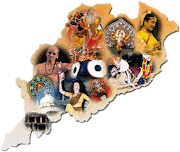Angul is clothed with lush green forests, the district is rich in varieties of wildlife. The River Mahanadi passes through this district forming a 22-km long narrow gorge, one of the mightiest gorges in India. Popularly known as 'Satkosia', it is an ideal habitat for varieties of crocodiles. The phenomenon of boulders in Talcher area is unique in India and has puzzled the geologists for centuries.Recently, it has come to limelight with the establishment of National Aluminium Company Ltd. (NALCO), the largest in Asia. As an important road junction, Angul serves the ideal base for visiting the places of interest in its neighborhood.At present the location advantage and abundant stock of manpower and raw materials play an important role in the industrial development of the district.
Location
Angul is located in central Odisha (Formerly Orissa), eartern province of India. It is 136 KM by road from Bhubaneswar, the capitol city of Odisha (Formerly Orissa). Other neighbouring towns of Angul are Dhenkanal in the south-east, Keonjhar in the north, Sambalpur in the west and Phulbani in the south-west.
How To Get There
Air: The nearest airport is at Bhubaneswar (160-km), which is connected with New Delhi, Calcutta, Chennai, Mumbai, Vishakhapatnam, Hyderabad and Nagpur by Boeing flights.
Rail: Angul is well connected from Bhubaneswar and Sambalpur through railway lines and there are several trains goes to Angul throughout the day. Train is the most comfortable and cheapest means of travel to Angul.
Road: Situated on NH 42 at a distance of 160-km from Bhubaneswar, the place is an important road junction of the State connected by regular bus services from Bhubaneswar, Cuttack, Dhenkanal, Talcher, Sambalpur, Sundargarh, Rourkela, Raipur, Durgapur and other important places of the State and sister States.
Best time to visit
October to March
Shopping
Cottage industry plays an important role in the rural economy of Angul district. Besides handloom, the other important cottage industries are carpentry, brass and bell metal works, shoe making, etc.
Transport: Taxis and Auto rickshaws are available on hire at Angul for visiting the places of attraction and excursion.
Tourist Attractions
Satkosia Tiger Reserve
Satkosia spreads along the magnificent gorge over the mighty river Mahanadi in Orissa. Established in 1976 as a wildlife sanctuary, Satkosia is a paradise of immense scenic charm. It is one of the best ecosystems in the country, representing a diverse floral and faunal extravaganza.The name Satkosia originates from two words; sat meaning seven and kosk meaning two miles, indicating the length of the gorge as 14 miles or 22 km.
The area was declared as Satkosia Tiger Reserve in 2007, comprising two adjoining wildlife sanctuaries; the Satkosia Gorge sanctuary and Baisipalli sanctuary. The reserve is spread over 4 districts; Angul, Cuttack, Nayagarh and Boudh. The reserve has an area of 964 sq km with 524 sq km as core area. The area is also a part of the Mahanadi elephant reserve. Satkosia is the meeting point of two bio-geographic regions of India; the Deccan Peninsula and the Eastern Ghats, contributing immense biodiversity.
Bhimakand:
It is a small village about 30-km north of Talcher town and 50-km from Angul on the Right Bank of the river Brahmani. There on huge sand rock one could find a massive image of Vishnu in sleeping posture. In spite of hugeness, the image contains a natural softness in execution. The period of its execution is believed to be 8th - 9th Century AD This sleeping image of Vishnu at Bhimakand is second only to Gomateswar (Karnatak) in size, but it has the honour of being the largest sleeping image in India.
Deulajhari:
Situated amidst a bowl of green near Athamallik, Deulajhari is famous for the presence of a hot spring. The hot spring seems to flow from the bottom (pedestal) of a 'Shiva Lingam'. The water is naturally channelised to 36 ponds on the outskirts of the Shiva Temple. Believed to contain medicinal properties, a bath in the spring has religious importance too.
90-km from Angul, regular bus services are available from Angul, Dhenkanal, Talcher, Cuttack and Bhubaneswar to Athamallik and the rest 3-km is negotiable on foot or jeep.
Rengali:
River Brahmani shelters a dam and reservoir with a Hydroelectric Project at Rengali amidst picturesque environs. Situated 85-km from Angul, it is a nice place for group picnic.
Samal:
40-km from Angul and 20-km from Talchar, Samal has carved out a niche for itself in the grand hall of Odisha (Formerly Orissa) tourism for the establishment of a Hydroelectric Project. The panoramic view with deep solitude is a panacea to the group picnickers.
Khuludi:
The Malayagiri range of Pallahara subdivision in Angul district houses a glittering waterfall near the village Khuludi. The fall making a spectacular jump from the hilltop pays homage to Lord Shiva on the foothill. An ideal site for group picnic, it is 120-km from Angul and 20-km from Pallahara.

